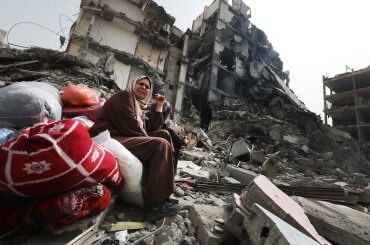Today, the road from Jerusalem to Bethlehem is marred with checkpoints and Israeli soldiers; imposing red signs warn travelers in Hebrew and English to turn around and return to Jerusalem, or enter Area A “at your own risk”.
Less than 6 miles separate the two cities but for Palestinians travel between them is an arduous endeavor. But not for the thousands of Israelis living in the massive illegal settlement bloc Gush Etzion near Bethlehem as they have only a quick ride on the settler-only Egged bus.
This is part of the reality and one of seven distinct themes that Bshara Nassar, co-curator of the upcoming art exhibit Bethlehem: Beyond the Wall, wants visitors to take with them when it premiers in New York at Manhattan College on February 19.
“We are telling a story beyond the news and beyond headlines,” Nassar told me. “A story that reflects everyday life.”
Often the narrative of the Palestinian people is imposed from the outside, Nassar said, and Palestinians’ stories “are really trapped in the politics of power, the UN resolutions, the endless negotiations.”
Nassar’s roots in Bethlehem go back generations. His grandfather Daher Nassar purchased the 400 dunams (100 acres) of farmland a few miles south of Bethlehem in 1916 that for more than a century the Nassar family has cultivated and maintained. Known for their peace-building initiative Tent of Nations, the farm has long welcomed visitors from around the world, often in solidarity with the Nassar family’s fight to keep the land from seizure by Israel’s rapidly-expanding settlement blocs.
“Bethlehem: Beyond the Wall” displays the explicit and generational effects of these shifting political boundaries through maps, seven original paintings by residents of the Dheishe refugee camp, over one-hundred photos, including journalistic, family and archival photos, four video interviews, and a one-minute drone fly-over video of the drab occupation wall that encircles the city. The exhibit begins with pieces from the late 1800s, bridging Bethlehem’s history to the city in the contemporary.
“Everyone knows what Bethlehem is,” Nassar said. However, “people actually don’t know much about Bethlehem.”
In the American consciousness Bethlehem “exists only in the bible or the Old Testament,” shrouded in myth.
But the city today, where Nassar collected much of the work on display, “has rich culture, arts, history, three refugee camps and a wall that most people don’t know about in the United States.”
“People in Bethlehem can’t run more than a couple of miles because of the wall, so they have to go in circles,” Nassar said, describing a photograph in the exhibit that shows the separation wall casting a shadow on the marathon runners in the foreground (photo at top).

Both Nassar and co-curator of the exhibit Dr. Mary Panzer are skilled at presenting portraits of real people and places.
Dr. Panzer is the former Curator of Photographs at the Smithsonian National Portrait Gallery as well as an active member of the Rochester, New York chapter of Jewish Voice for Peace. “Bethlehem: Beyond the Wall” showed in Rochester in the fall of 2017 to much praise.
As for Nassar, the inspiration to begin the work of telling Palestinian narratives came to him upon moving to Washington D.C. in 2011. As a tourist he visited the many museums, monuments and memorials in the city but did not see his people nor culture represented.
“I saw how proudly Americans tell their stories to museums. I saw that many immigrants who came to this country have told their stories to these museums,” Nassar told me, “but I couldn’t find a place to tell my story as a Palestinian.”
Realizing that other Palestinians in the diaspora likely shared his frustration, Nassar founded the Museum of the Palestinian People to showcase Palestine through its history and culture, as well as to represent the daily lives of those in the diaspora and at home.
Bethlehem: Beyond the Wall is part of a larger effort to develop and expand the museum to new audiences. After New York, Nassar said, ideally the exhibit will continue to travel, reaching as many American cities as possible. In fact after the show first premiered, the museum received calls from individuals all over the U.S. asking if and when they could see it in their own city
“The Palestinian voice is slowly becoming mainstream in the United States,” Nassar surmised. “People in the U.S. are starting to get more receptive slowly because they are getting more exposed to Palestinian [art and culture].”
Palestinian film festivals are now held in most major North American cities, Palestinian models and actors appear in movies and television, and radio shows like Palestinians Podcast bring a uniquely Palestinian point of view to listeners around the world.
“New York is an important place for culture, so this upcoming show is particularly important as far as changing the narrative,” Nassar said.
“[Bethlehem] is the most famous city in the world” he added. “This exhibit brings the most famous city in the world to reality, to touch.”
The Bethlehem: Beyond the Wall Art Exhibition will be on view from February 19-27, 2018 at Manhattan College in the Bronx. It will be housed in Kelly Commons room 5A, Monday through Saturday from 10:00 a.m. to 7:00 p.m.



“The Palestinian voice is slowly becoming mainstream in the United States,” Nassar surmised. “People in the U.S. are starting to get more receptive slowly because they are getting more exposed to Palestinian [art and culture].”
But in the meantime:
https://electronicintifada.net/content/new-york-bookseller-bowed-israel-supporters-after-violent-threats/23301